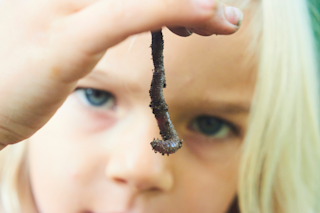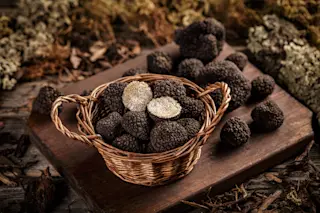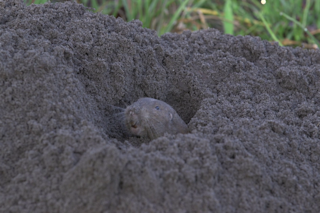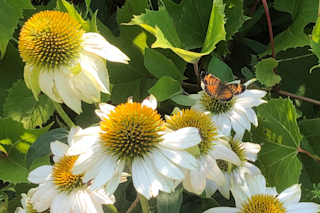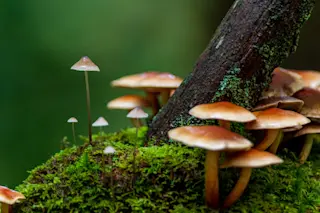Ian Baldwin works in a lab anyone could love: a large blackened burn area high on a steep slope in the Great Basin Desert of southwestern Utah. Here a distant mountain range shimmers blue and lavender, the nearer craggy cliffs of Veyo Ridge hover in red, and the curves of the desert hills are dotted green by Joshua trees and scrub. Baldwin, a biologist and the director of the Molecular Ecology Department at the Max Planck Institute for Chemical Ecology in Jena, Germany, has stationed his equipment here to launch a new study of how plants defend themselves—a question he has pursued for 20 years.
He and his colleagues are using chemical sensors to investigate plant communications: cries for help, invitations, even warnings, each in the form of odor molecules that float past human noses unnoticed. The harder biologists look for these signals, the more they find. They have already discovered that plants can send chemical cues to repel insect enemies, as well as signals that attract allies—other insects that are pleased to eat the insects eating the plant. But that is only the start of a more complex scenario, for Baldwin and others have also found that nearby plants can listen in to this conversation and gear up their own defenses.
"Eventually, we will use the information we get here to breed agricultural crops that call out to their insect allies more loudly and more consistently," says Baldwin.
The scorched area they're studying was struck by lightning a year ago, clearing the hillside of juniper and sagebrush. Smoke from the fire triggered the germination of wild tobacco seeds dormant in the soil, yielding a field of Nicotiana attenuata. Baldwin's team has tagged many of them for experiments, using Popsicle sticks and small flags made of red nylon. Chatting in German and English, Baldwin's colleagues look expectantly for golden eagles. The day is hot, the air scented with desert cliff rose.
Tobacco plants are good subjects because they must be especially agile with their defenses if they are to survive. The seeds can lie dormant for over a century between fires, so the plants may face new enemies once they start growing. Moreover, when the seed germinates, it has only one season to flower and reproduce—and avoid being demolished by insects. "It has to optimize its growth, and it has to strategize against herbivores, always watching the bottom line, which is setting seed," says Baldwin. "These plants have an amazing plasticity. They have to respond to the environment, which is always changing. A number of insect species feed on N. attenuata, and it is a different mix of species every year."
Successful seedlings must fend off the caterpillars of certain hawkmoths, not to mention leaf bugs, flea beetles, and tiny mirids. Baldwin and Andre Kessler, a graduate student, have helped nature along by bringing with them laboratory-raised caterpillars. They place a hungry caterpillar on several of the plants. Over the next few days, they return with a solar-powered gas chromatograph to detect molecules emitted by the damaged leaves. They also check to see what nearby control plants, sans caterpillars, are doing.
Scientists have known for some time that plants can activate powerful defense systems, much as humans churn out antibodies to defend against pathogens. When a caterpillar bites into a leaf, for example, the plant recognizes compounds in the insect's saliva and initiates a chemical defense. Many plants produce toxins (nicotine works well) to kill the insect, as well as compounds that slow down or stop the invader's ability to digest the plant.
Should that fail, there is a second line of defense. A tobacco plant under attack also releases a blend of airborne chemical repellents. In one recent study, Baldwin and Kessler were able to identify, isolate, and test some of these emissions. When they combined the specific chemicals into a paste and smeared it on the stems of plants that had not yet been attacked, hawkmoths avoided laying eggs on them.
Baldwin wanted to find out whether tobacco plants had even more weapons in their arsenal. So he designed an experiment to see if they could summon help. First, he treated the plants with a range of synthetic pastes. Sometimes the paste contained only one of the volatile compounds they had earlier identified, and sometimes it contained a blend of these compounds. Next, they glued the eggs of hawkmoth caterpillars to the underside of the treated plant's leaves. Then they kept an eye out for Geocoris pallens, an insect that likes to eat the eggs. Sure enough, three of the compounds emitted by tobacco plants seemed to attract G. pallens, a small, fast, and rapacious predator.
"By releasing certain volatiles, a plant can reduce the number of herbivores attacking it by as much as 90 percent," Kessler says with admiration. "Chemical signaling is normal. This kind of communication is normal. I think it is probably going on all the time, all around us."
Baldwin explains how he thinks the signals developed. "You're wounded. You emit something. An insect responds. A mutualism evolves."
Baldwin is one of the first in his field to investigate chemical signaling among plants in the wild. Previous experiments had focused on signaling in domesticated crops, and all that work was done in controlled environments, in bell jars and labs and greenhouses with altered atmospheres. Wind tunnels were supposed to mimic one of nature's wilder forces.
Some of the most complex studies came out of these controlled environments. In 1988 Marcel Dicke and his colleagues at Wageningen University in the Netherlands offered evidence that plants under insect attack could enlist help from the enemies of their enemies. Dicke found that when spider mites attack lima bean plants, the plants release a chemical SOS that attracts another mite that preys on the spider mite. Mechanically damaged plants do not produce the cues; most likely, only elicitors in the saliva of the insect can trigger the plant to produce the right molecules. "Today," Dicke says, "the scientific community agrees that plants talking to their bodyguards is likely to be a characteristic of most, if not all, plant species." Even the gingko—a species that has been around for 150 million years—can communicate chemically with insects, he adds.
For example, when caterpillars feed on corn, tobacco, and cotton, the beleaguered plants produce airborne chemicals that attract parasitic wasps. The chemical cries for help are quite specific, attracting only the wasps that lay their eggs in the type of caterpillar infesting the plant. "Plants are not just saying, 'Yes, I am damaged,' they are also saying specifically who is damaging them. It is such an intricate and fabulous system," says Consuelo De Moraes, an assistant professor of entomology at Pennsylvania State University.
Plants can also time the release of different signals to have different effects. Parasitic wasps hunt during the day, for example, so that's when infested plants release their SOS. Plants time the emissions of repellents as well. In studies of commercial tobacco, De Moraes and her colleagues found that caterpillar-infested plants release a chemical blend at night that seems to discourage nocturnal moths from laying eggs that in turn would produce tobacco-devouring caterpillars.
The idea that plants can signal insects has long made sense to scientists. But the concept that plants can communicate with other plants has not, as Baldwin learned back in the early 1980s while still an undergraduate at Dartmouth College. He was studying trees with biologist Jack Schultz, and in 1983 they published a controversial hypothesis: Airborne chemical cues from damaged maple and poplar trees seemed to boost the chemical defenses of undamaged trees nearby. The Secret Life of Plants, a best-seller in the 1970s, had sold the public on the notion of talking to philodendrons, and now it seemed the philodendrons were talking back. Inter-tree communication! Maples whispering to other maples! Reports in the popular press about Baldwin and Schultz's work appeared first in the National Inquirer and later in both People and The New York Times. Scientists were dismissive, and the resulting furor made it difficult for Baldwin and Schultz to get further studies funded.
Time, persistence, and good science has changed attitudes. Several months ago Dicke helped produce a special issue of the journal Biochemical Systematics and Ecology filled with papers on plant-to-plant communication. Researchers now find it reasonable that plants can pick up on—and use—each other's signals. "If plants talk to their bodyguards," says Dicke, "then why would their neighbors not take advantage of that and eavesdrop on the message? The topic of plant-to-plant communication is back on the agenda, and the evidence is accumulating."
Dicke and his colleagues have found that mere exposure to airborne emissions from mite-infested cotton and lima beans will prompt undamaged plants to release signals that summon an enemy of the infesting mite. Over the last 19 years, in various experiments, researchers say they've caught willow, poplar, alder, and birch trees listening to their own kind and barley seedlings listening to other barley seedlings. In each case, damaged plants, whether eaten by caterpillars, infected by fungus or powdery mildew, infested by spider mites, or even clipped mechanically, sent out chemicals that seemed to jump-start the defenses of undamaged plants nearby. Researchers are also testing soil to see if plants release chemical warnings from their root systems.
Even unrelated plants can pick up on chemical alarms. Studies by Baldwin's team and others have shown, for example, that sagebrush normally emit an airborne version of a defensive signal; cut or wounded sagebrush release more than six times as much of the signal as unharmed sagebrush. Tobacco plants transplanted downwind of the wounded sage suffer less insect damage than tobacco plants transplanted downwind of unwounded sage. Other studies have found that cucumbers seem to respond to the signals of injured lima beans.
"We have been slow to appreciate," says Jack Schultz, now a professor of entomology at Penn State, "that plants do many similar or even identical things when responding to insects that they do when responding to pathogens. A completely parallel story may emerge here in the way plants detect nearby infection and gear up for it."
Still, biologists who study plant signaling are careful not to overstate their results. Schultz, who continues to collaborate with researchers like Consuelo De Moraes, believes that Baldwin's pioneering research outside the laboratory brings us much closer to understanding how plants communicate chemically in a natural ecosystem. But Schultz cautions that more experiments must be done. Biologists haven't yet documented the signal traveling from plant A to plant B, and many variables can influence a plant's response: wind, drought, light, touch, and disease. "There are a lot of interacting factors to be sorted out," he says.
A wild tobacco plant grows on a burned site in southwestern Utah. It must deploy an arsenal of chemical weapons to keep voracious insects at bay. "It's remarkable that any part of the world is still green," says Baldwin.
Dicke adds that individual plants respond differently to insect attack. How they respond may depend on the availability of nutrients and whether the plant would rather invest in growth or defense. Or it may depend on the age of the plant and whether it would rather focus on growth or reproduction. Or it may depend on the previous experience of the plant, which might strengthen its response.
"Showing how things work outdoors is crucial," Schultz says, "but it is not at all easy."
Information from the wild, where few researchers have ventured, could lead to truly revolutionary changes in agriculture. Farmers now rely on heavy pesticide use because domestic plants, which have been bred for high yield, have often lost their native chemical defenses and cannot call out for help. A wild cotton plant, for example, can emit up to 10 times more airborne emissions that summon parasitic wasps to attack infesting caterpillars than a hybrid can.
"Crop plants have been selected for improved yield and high-quality yield and for resistance to pests and disease," explains Dicke, "but never for compatibility with biological control. The latter is essential for the development of durable and environmentally benign pest control. In nature, plants are exposed not only to herbivores but also to a multitude of those herbivores' natural enemies. In agriculture the number of natural enemies is usually reduced because agricultural systems are usually much more simple. Those natural enemies that are there—or that we introduce there—should be cherished, and their labor conditions should be optimized so as to take full advantage of their services."
Researchers in developing countries are already using knowledge of plant communications to devise arrangements that push pests away from one crop and pull them toward another target. In East Africa, where stem-borer caterpillars devour fields of maize and sorghum, planting molasses grass in the fields pushes pests away. The molasses grass emits airborne chemicals that repel stem borers and attract the caterpillar's predator, a parasitic wasp. At the same time, plants that stem borers like to eat can be grown around the fields, pulling the pest from the main crop. To some extent this mimics what good gardeners have always known intuitively: Certain plants seem to do well together.
Baldwin and Kessler hope their research indicates nature-based pest control might be easily adapted to many plant varieties. The wild tobacco plant, they've found, emits an array of common compounds that attract an all-purpose insect ally whose tastes range from caterpillar eggs to leaf bugs and mirids.
"The natural system may not be so fine-tuned or so specialized that we can't reproduce it fairly easily," Baldwin says. "We don't have to get it perfectly."
It's nearing dusk, and Baldwin and Kessler are setting up their equipment. Silhouetted against blackened brush, Baldwin pauses to listen to a bird. "Sounds like an oriole," he says.
"No," says Kessler, "a mockingbird imitating an oriole."
The landscape around them is filled with chatter. Some of it can be heard; some of it must be sensed. Signals are being sent. Information is being exchanged. Like gossips tilting their heads in the direction of a juicy conversation, both men lean down, bending closer to a tobacco plant.



